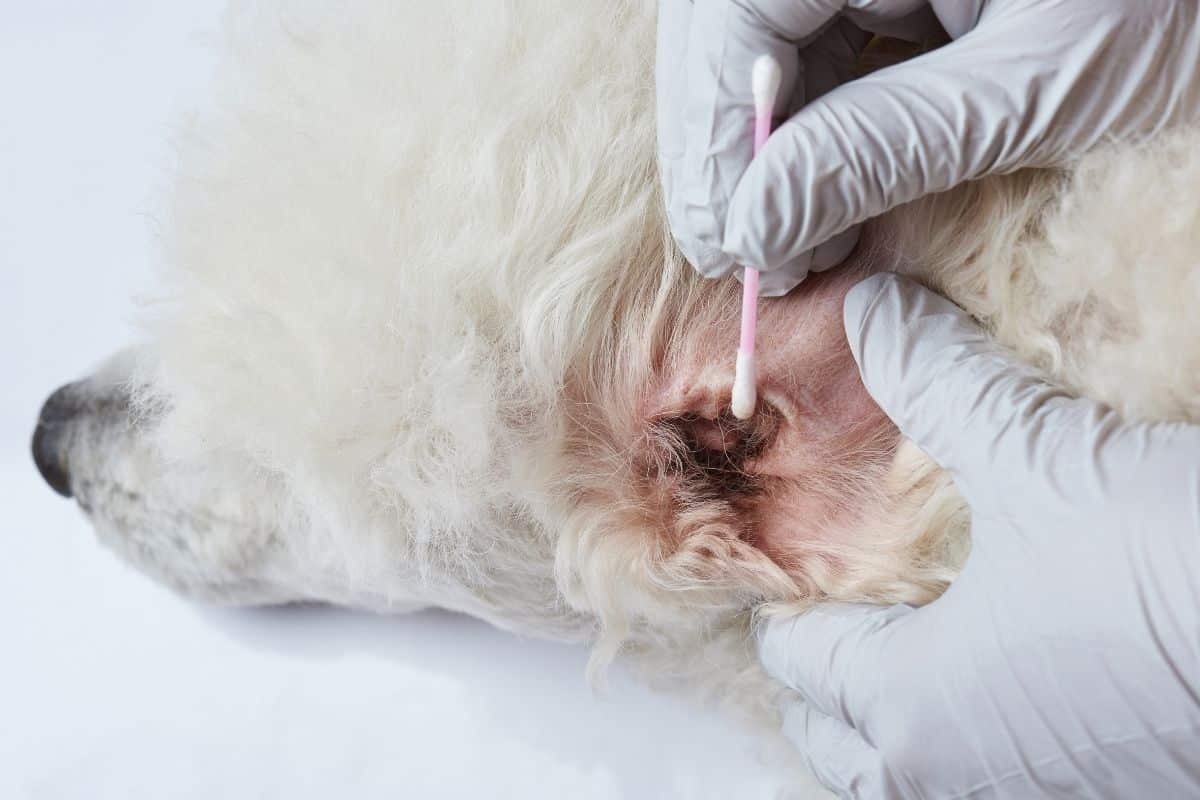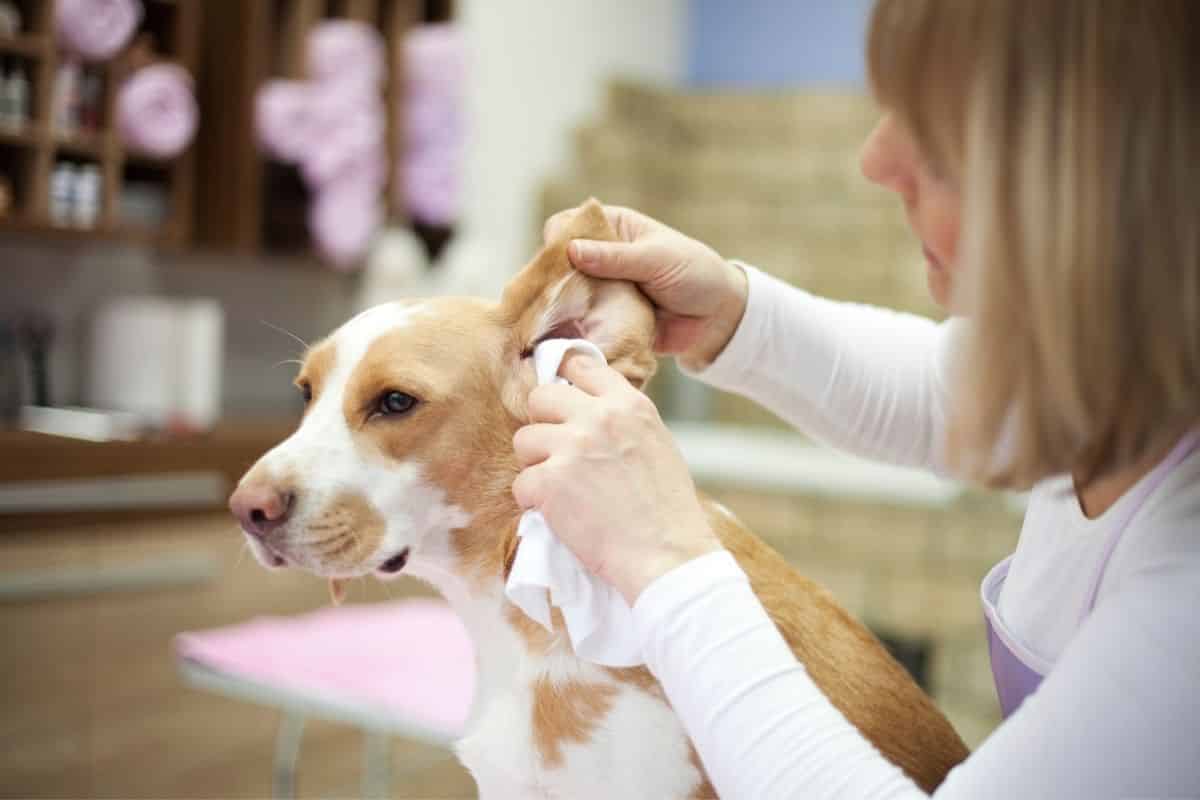Earwax is a part of everyday life, including dogs’. It might not be the most pleasant stuff, but it serves a purpose and plays an important role in healthy individuals.
Many owners pay little attention to their pets’ earwax, and why wouldn’t they? It is something we overlook a lot, but it can tell you a lot about your pet.
If you’re reading this, you might have recently noticed black earwax in your pet’s ears. If you have, then you might be wondering what it means.

Is black earwax normal? Or is there something more unusual and sinister afoot? If you’ve noticed that your dog has black earwax, and would like to learn a little more about what that means, you’re in the right place!
Here, we will be going through everything you need to know about black earwax.
About Earwax
Earwax is very essential for most animals, especially dogs. Not only does it prevent ear canals from becoming dry and itchy, but it also helps fight off infections.
Earwax also acts as a shield for the eardrum, protecting it from the dangers of the outside world. In dogs, earwax is important because:
- It protects the inner ear from foreign objects or other things which could injure them
- It keeps debris and allergens from entering the ear canal
- It helps keep water out of the ear canal
- It reduces the risk of bacterial infection by acting as a barrier between the bacteria in the external environment and the internal ear
What Is Earwax Made Of?
The composition of earwax varies depending on many factors, such as breed, age, diet, health, etc. However, the basic components are similar across all breeds.
The main component of canine earwax is sebum (or oil), which is produced naturally by glands surrounding the ear canal. Although it may seem unnecessary, some people believe that some of this oil gets into the outer ear canal.
This excess oil can come out of one’s ears when they shake their head, or when they rub their heads against furniture, bedding, etc. When they do this, the excess oil can drip down onto clothing and hair. But it doesn’t really matter where the excess oil ends up—it’s just a waste product.
You should note that the amount of earwax in each individual can vary significantly. Some dogs produce large amounts, while others produce almost none at all.
Earwax also depends on the season – dogs with long fur generally have less oil than those who are short-haired.
How Much Earwax Is Normal?
All dogs should have a healthy amount of earwax. Although there is no set way to determine how much earwax is ‘normal’, different veterinarians use different scales to measure the amount of wax in each animal.
For example, some vets might consider 3 mm to 6 mm of earwax normal, whereas others might consider 5 mm to 8 mm to be normal.
Ultimately, you’ll want to work with your vet to find the best method for measuring your dog’s earwax, so that you can get an accurate idea of what level of earwax is ‘healthy.’
The breed of your dog, along with their age and diet, could play a part in their earwax. It’s important to note that some breeds, like Cocker Spaniels, often have genetic conditions that result in more wax being produced.
Excessive wax buildup is a common issue for dogs that have very long ear canals, like Basset Hounds.
Can Dogs Have Too Much Earwax?
Yes, dogs can have too much earwax. Most veterinarians will tell you that if your dog has excessive earwax, then it is likely due to an underlying medical disorder.
If your dog seems to have more earwax than usual, you should take them to see a veterinarian right away. A veterinary exam allows your doctor to help rule out any underlying conditions that might cause excessive earwax production.
If you notice that your dog’s ears look particularly dirty, then you should definitely clean them gently. You may even want to try cleaning them after bathing your dog, since most pet owners don’t realize that the moisture in the air actually makes earwax stickier!
Make sure to get rid of any wax build-up before going outside, especially if you live somewhere humid.
Can Dogs Have Too Little Earwax?
Yes, dogs can also have too little earwax. This might happen because of genetics or because of an illness.
An inherited condition called alopecia syphilitica causes loose skin around the face, including the ears, muzzle, and paws. This results in patchy areas of bare skin that lack sweat glands.
Since the only function of earwax is to protect the inner ear, it makes sense why these patches would dry out and lose their natural oils. In addition, a bacterial infection in a dog’s ear can lead to decreased secretion of earwax.
Earwax Colors
You do get different earwax colors. These colors range from white to yellow to brownish coloration, and sometimes even black.
However, not every dog will have this type of variation in their earwax coloration. Sometimes the coloration changes throughout the year, as well.
Does The Color Of The Earwax Matter?
The color of your dog’s earwax does matter. Some dogs produce lighter colored earwax because they have less oil secreted by their glands.
The color of your dog’s earwax is based on the oils present in the outer layer of the ear canal. When the oil content decreases, the earwax becomes paler. The darker the earwax in your dog’s ear, the heavier the oils are.
As long as the oil content inside the ear remains high, the earwax stays dark. On the other hand, when the oil content drops below 50%, you might start seeing light earwax.
Care

Your dog’s ears need to be properly taken care of. Although ears will usually do a good job of cleaning themselves, you might need to intervene sometimes. Depending on the breed of dog you have, frequent ear cleaning should become a habit.
If you are unsure of your dog’s earwax, you should always speak to the vet. This is especially important if you have a dog that you are unfamiliar with, as there are going to be some differences between breeds.
Your vet can show you how to deal with your dog and what you can do to ensure that there is as little wax buildup as possible.
Is There A Way To Get Rid Of My Dog’s Earwax?
There are several ways to remove excess earwax from a dog’s ears. Your veterinarian might recommend removing all the accumulated earwax first. Afterward, you’ll need to apply petroleum jelly to the area many times per day until the wax returns to normal.
If you notice a lot of earwax accumulating again soon after applying the product, then you might consider using another method to deal with the problem.
You should frequently check your dog’s ears for wax buildup, especially if they have long ear canals. Wax buildup can impair a dog’s hearing, and if left untreated, it can be painful.
If you notice that there is some excessive buildup, you should take your dog to the vet immediately. It could indicate an underlying health issue.
How Can I Prevent My Dog From Getting Too Much Earwax?
It is possible to prevent a dog from getting too much earwax, but it requires proper nutrition. In general, the ideal diet for a dog has plenty of omega 3 fatty acids. However, the key to preventing wax build-up is to regularly clean your dog’s ears.
Cleaning Your Dog’s Ears
To clean your dog’s ears, you should use a cotton ball soaked in warm water and petroleum jelly. You may want to trim any stray hairs that get caught in the ear before cleaning them. Be gentle while you clean your dog’s ears, so you don’t cause any damage or discomfort.
Always look carefully at your dog’s ears to make sure you aren’t missing anything. If you find a foreign object like a stick or wire sticking out of your dog’s ear, you should gently pull it out.
Don’t force anything out of your dog’s ears. You can always ask your vet to give you a prescription medication to help relieve pain. Finally, remember to keep up with regular veterinary care!
It might be tempting to use something like a Q-tip, but you should NEVER do this. The same risk applies to dogs as it does humans. By using a Q-tip, you risk perforating the eardrum and causing serious damage to your dog. You should only ever use cotton balls, or something similar.
Nothing hard should go into the dog’s ears, and nothing should go in deep. Using cotton balls and a good quality ear cleaning solution will work perfectly for your pet.
Black Earwax
Black earwax is nothing you should be worried about, unless your dog is in discomfort. It’s merely a sign of wax buildup. You should be cleaning your dog’s ear more frequently if you notice black earwax.
Some breeds do not have the ability to clean their ears as well as others. Because of this, it might take longer for the wax to make its way out the canal.
Final Thoughts
Earwax is important to our furry friends, just like it is to us. Our dogs can suffer from earwax buildup, or even have too little.
Most earwax is normal, including the wax that appears to be black. If your dog’s earwax is black, it simply means that it has been in the ear canal for a long time.
This itself is not a cause for concern, but you should keep an eye out in the future. Your dog may suffer from a buildup of earwax, which could harm them.
If you have noticed black earwax in your dog’s ears, and are worried about it, get in touch with your local vet. Earwax buildup is a relatively common occurrence, and can be managed fairly easily. By following your vet’s guidelines, you will help your dog feel happy and healthy.
- What Dog Breeds Have Pink Skin? - March 24, 2023
- What Are the Most Inspiring Dog Breeding Quotes? - March 20, 2023
- Can Pheromone Spray Help Improve Dog Breeding Results? - March 19, 2023








